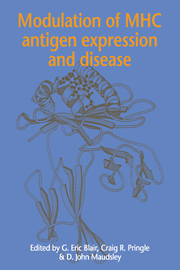Book contents
- Frontmatter
- Contents
- List of contributors
- Preface
- List of abbreviations
- 1 General introduction to the MHC
- 2 Organization of the MHC
- 3 Interactions of cytokines in the regulation of MHC class I and class II antigen expression
- 4 Control of MHC class I gene expression
- 5 Control of MHC class II gene expression
- 6 Modulation of MHC antigen expression by viruses
- 7 Modulation of MHC antigen expression by retroviruses
- 8 Modulation of MHC class I antigen expression in adenovirus infection and transformation
- 9 MHC expression in HPV-associated cervical cancer
- 10 Inhibition of the cellular response to interferon by hepatitis B virus polymerase
- 11 Cellular adhesion molecules and MHC antigens in cells infected with Epstein-Barr virus: implications for immune recognition
- 12 Effect of human cytomegalovirus infection on the expression of MHC class I antigens and adhesion molecules: potential role in immune evasion and immunopathology
- 13 Oncogenes and MHC class I expression
- 14 Mechanisms of tumour cell killing and the role of MHC antigens in experimental model systems
- 15 Manipulation of MHC antigens by gene transfection and cytokine stimulation: a possible approach for pre-selection of suitable patients for cytokine therapy
- 16 Overexpression of MHC proteins in pancreatic islets: a link between cytokines, viruses, the breach of tolerance and insulindependent diabetes mellitus?
- 17 The role of cytokines in contributing to MHC antigen expression in rheumatoid arthritis
- 18 Expression of an MHC antigen in the central nervous system: an animal model for demyelinating diseases
- Index
8 - Modulation of MHC class I antigen expression in adenovirus infection and transformation
Published online by Cambridge University Press: 11 September 2009
- Frontmatter
- Contents
- List of contributors
- Preface
- List of abbreviations
- 1 General introduction to the MHC
- 2 Organization of the MHC
- 3 Interactions of cytokines in the regulation of MHC class I and class II antigen expression
- 4 Control of MHC class I gene expression
- 5 Control of MHC class II gene expression
- 6 Modulation of MHC antigen expression by viruses
- 7 Modulation of MHC antigen expression by retroviruses
- 8 Modulation of MHC class I antigen expression in adenovirus infection and transformation
- 9 MHC expression in HPV-associated cervical cancer
- 10 Inhibition of the cellular response to interferon by hepatitis B virus polymerase
- 11 Cellular adhesion molecules and MHC antigens in cells infected with Epstein-Barr virus: implications for immune recognition
- 12 Effect of human cytomegalovirus infection on the expression of MHC class I antigens and adhesion molecules: potential role in immune evasion and immunopathology
- 13 Oncogenes and MHC class I expression
- 14 Mechanisms of tumour cell killing and the role of MHC antigens in experimental model systems
- 15 Manipulation of MHC antigens by gene transfection and cytokine stimulation: a possible approach for pre-selection of suitable patients for cytokine therapy
- 16 Overexpression of MHC proteins in pancreatic islets: a link between cytokines, viruses, the breach of tolerance and insulindependent diabetes mellitus?
- 17 The role of cytokines in contributing to MHC antigen expression in rheumatoid arthritis
- 18 Expression of an MHC antigen in the central nervous system: an animal model for demyelinating diseases
- Index
Summary
Introduction
Human adenoviruses (Ads) possess two well-studied mechanisms for modulation of MHC class I expression. The mechanism that is predominant in infected cells involves down-regulation of surface class I antigens caused by a block in the transport of class I heavy chains to the cell surface. This block is effected by a protein product of a viral early gene (termed E3) and seems to operate in cells infected with most virus serotypes. In adenovirus-transformed cells, the level of surface class I antigens can be either elevated or decreased depending on the serotype of the transforming adenovirus and is controlled mainly at the step of transcription of class I genes. Modulation of the rate of initiation of class I gene transcription in these cells is mediated by the product(s) of a different viral early gene (E1A). Interestingly, it is the expression of the E1A gene of highly oncogenic adenoviruses (such as Adl2) that results in down-regulation of class I transcription, providing a possible mechanism whereby oncogenic Adl2-transformed cells can escape host immune surveillance and form tumours. Adenovirus-infected and adenovirus-transformed cells are, therefore, interesting experimental systems for the study of class I modulation.
Adenovirus transformation and oncogenicity have been extensively reviewed (Knippers & Levine, 1989; Boulanger & Blair, 1991; Chinnadurai, 1992; Moran, 1993) and comprehensive reviews on virus structure, biology and pathogenicity are also available (Ginsberg, 1984; Doerfler, 1986; Horwitz, 1990a,b). The wider aspects of the immunobiology of adenoviruses have also been described (Wold & Gooding, 1991; Braithwaite et al, 1993).
- Type
- Chapter
- Information
- Modulation of MHC Antigen Expression and Disease , pp. 192 - 232Publisher: Cambridge University PressPrint publication year: 1995
- 1
- Cited by



